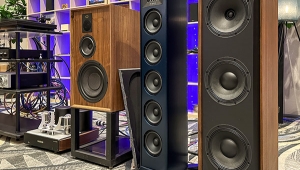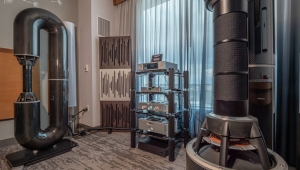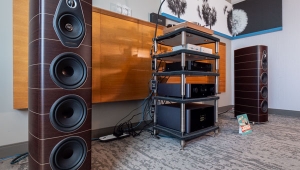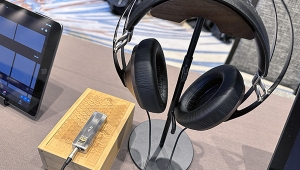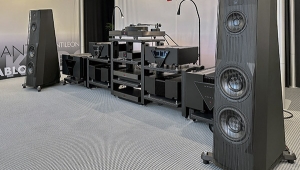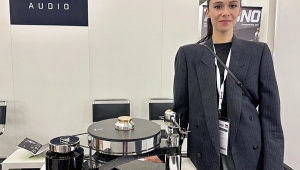| Columns Retired Columns & Blogs |
Yamaha, 70 Years Young, Blends Past and Present
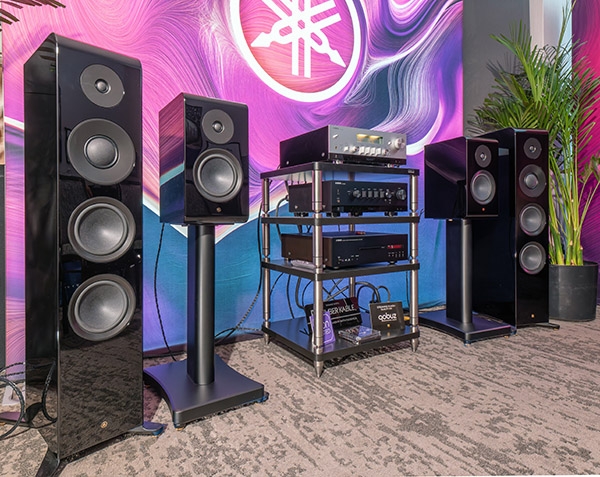
At audio shows, we don’t look back much. AXPONA is mostly about what’s new, what’s hot, what’s happening. Yamaha proudly bucked the trend and delved into the past. In two adjoining rooms on the 14th floor, the Japanese brand celebrated its 70th anniversary as a hi-fi company. The room on the right had been transformed into a history museum of sorts, with key products from yesteryear that helped lift the audio brand to global fame.

Those products included the boxy "Hi-fi Player," an F-11 turntable from 1954. The company says it was the first commercial product to use the term "hi-fi." Next to it stood the iconic, white-coned NS-10M monitors (1978–1993), still beloved in many recording studios today, not because they’re hyper-accurate but because they possess a sort of Everyman-marries-Goldilocks character; to generations of engineers, they came to represent typical at-home hi-fi sound. The NS-10Ms helped ensure that mixes sounded as good on real-world stereos as they did on better systems.
Also on display: a CR-2020, the blockbuster stereo receiver from the late 1970s that boasted a then-hefty 100Wpc into 8 ohms with harmonic distortion of less than 0.05%. Like some other '70s receivers—by Luxman, Marantz, and McIntosh—the CR-2020 has regained its cool in recent years thanks to handsome, timeless (but not anonymous) styling and still-excellent sound.
The Yamaha crew in the space next door demoed products from the past 12 months. The NS-800A two-way standmount speakers ($4800/pair) satisfied my desire to hear the latest of the latest; shipping to consumers had just started, Phil Shea of Yamaha USA said. The 800As’ cones are made of a blend of old and new materials including Zylon, a synthetic polymer said to be stiffer than steel and stronger than Kevlar, and spruce.
Shea told me that the spruce comes from the same stash the instrument-building branch of the company uses for guitar tops and the soundboards of pianos. Ports in the back are scalloped to reduce airflow noise, also known as chuffing.
All those attributes are shared by Yamaha’s NS-2000A three-way bass-reflex towers ($8000/pair). Launched last summer, The 2000As stand much taller (44.5" vs. 16.5") and dig a little deeper (34Hz vs. 40Hz) than their little brothers.
A Yamaha RN-2000A stereo receiver ($4000, introduced in 2023), equipped with an ESS SABRE ES9026PRO Ultra DAC, a MusicCast hi-res streaming module, and basic room-calibration capability, drove both pairs of speakers with authority and precision. I found the silver-finish model, which has a black band around the bottom, especially good-looking. Yamaha’s industrial designers are very, very good at updating the visual language the company developed decades ago. The newest Yamaha components look familiar and completely fresh at the same time. Love.

Beyoncé’s "Blackbird," awash in vocal harmonies that grab and won’t let go, sounded sweet and captivating on the NS-2000As. If I’m honest, a live studio recording of pianist Bob James’s jazz trio playing "Rocket Man" was too muzak-y for my taste, but his instrument—a Yamaha, natch—had real weight, dimensionality, and presence, so I left impressed anyway.
- Log in or register to post comments




